University HRM Task 3: Summative Assessment Report Analysis
VerifiedAdded on 2023/01/03
|11
|2409
|61
Report
AI Summary
This report, titled "Human Resource Management: Task 3," presents a comprehensive analysis of employee data management and its implications within an organization. The report begins by identifying the significance of maintaining employee records for legal compliance and effective decision-making, including meeting HMRC requirements and supporting informed HR and operational strategies. It then details the types of data collected, emphasizing the importance of educational background, skills, and work experience for training and placement purposes. The report advocates for digital storage methods, such as HRIS or spreadsheets, to ensure efficient data retrieval and accuracy, particularly for organizations dealing with part-time and temporary staff. Furthermore, the report addresses the implications of the General Data Protection Regulation (GDPR), focusing on lawfulness, transparency, accuracy, and confidentiality of employee data. Task 2 of the report analyzes absence and staff turnover rates across eight stores in the West Midlands using graphical representations. The analysis highlights the challenges faced by the organization in managing absenteeism and staff turnover, recommending further investigation into the underlying causes and the implementation of strategies to improve employee motivation and retention. The report concludes with suggestions for addressing high absence and turnover rates, including workplace improvements, training and development programs, and adjustments to staffing levels.
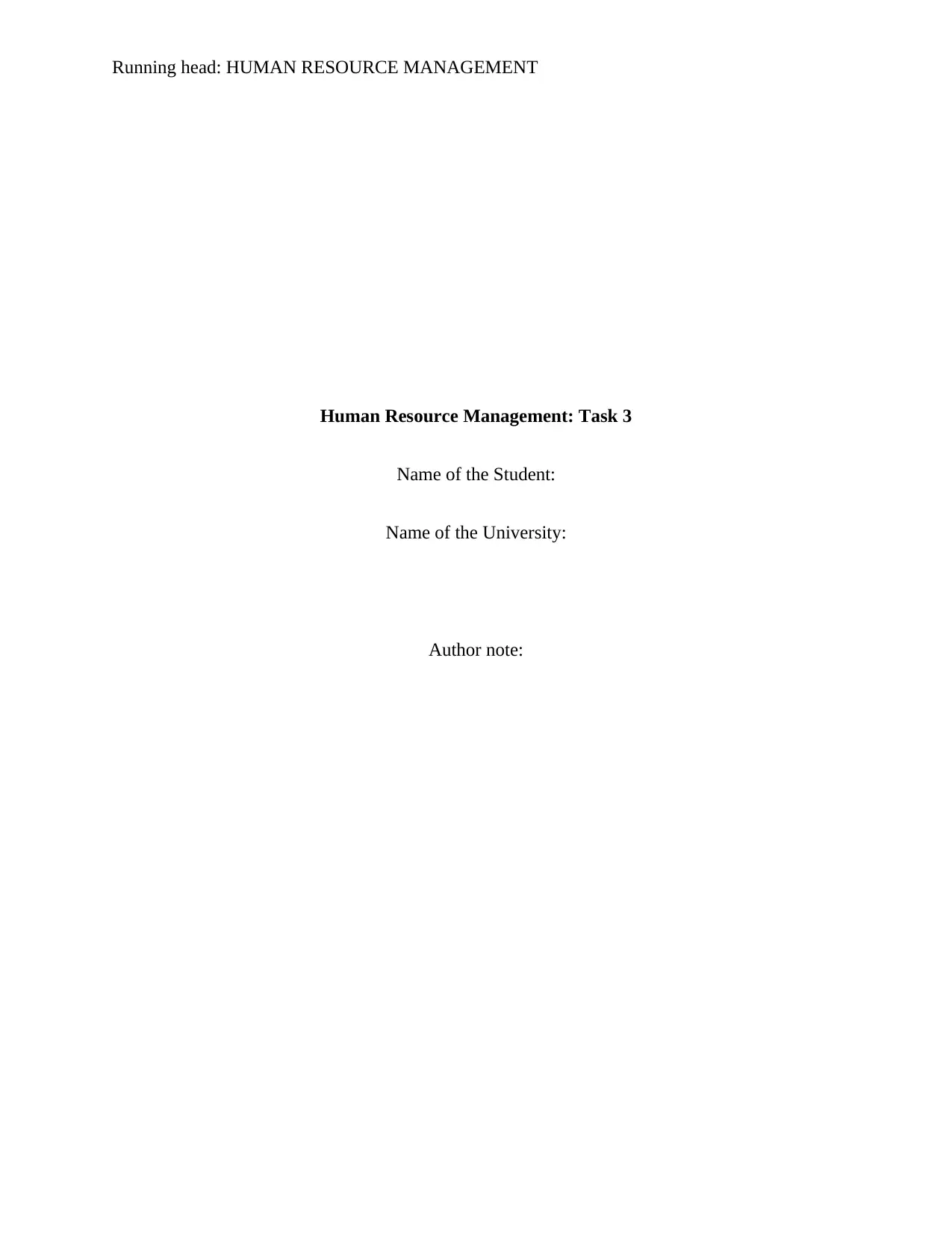
Running head: HUMAN RESOURCE MANAGEMENT
Human Resource Management: Task 3
Name of the Student:
Name of the University:
Author note:
Human Resource Management: Task 3
Name of the Student:
Name of the University:
Author note:
Paraphrase This Document
Need a fresh take? Get an instant paraphrase of this document with our AI Paraphraser
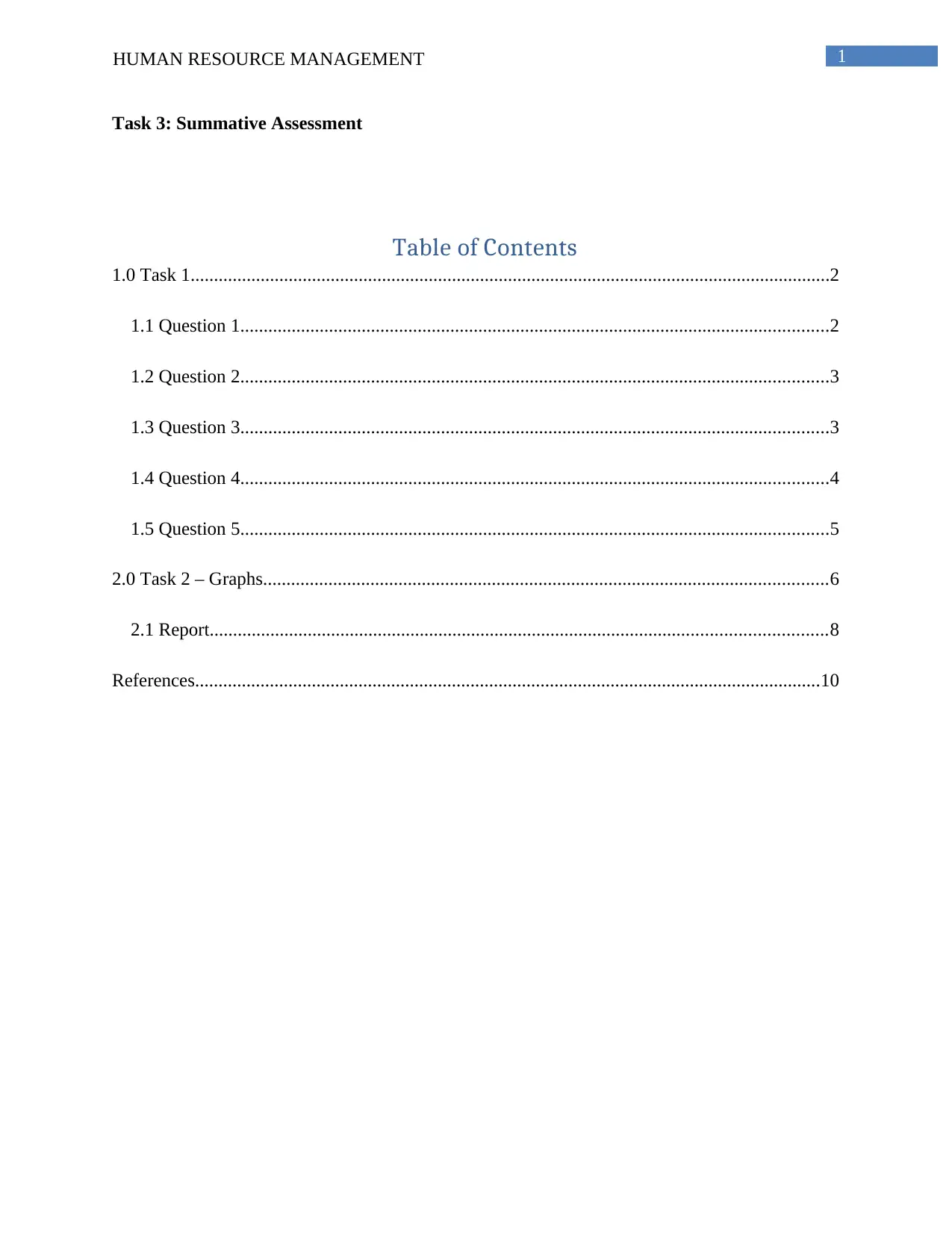
1HUMAN RESOURCE MANAGEMENT
Task 3: Summative Assessment
Table of Contents
1.0 Task 1.........................................................................................................................................2
1.1 Question 1..............................................................................................................................2
1.2 Question 2..............................................................................................................................3
1.3 Question 3..............................................................................................................................3
1.4 Question 4..............................................................................................................................4
1.5 Question 5..............................................................................................................................5
2.0 Task 2 – Graphs.........................................................................................................................6
2.1 Report....................................................................................................................................8
References......................................................................................................................................10
Task 3: Summative Assessment
Table of Contents
1.0 Task 1.........................................................................................................................................2
1.1 Question 1..............................................................................................................................2
1.2 Question 2..............................................................................................................................3
1.3 Question 3..............................................................................................................................3
1.4 Question 4..............................................................................................................................4
1.5 Question 5..............................................................................................................................5
2.0 Task 2 – Graphs.........................................................................................................................6
2.1 Report....................................................................................................................................8
References......................................................................................................................................10
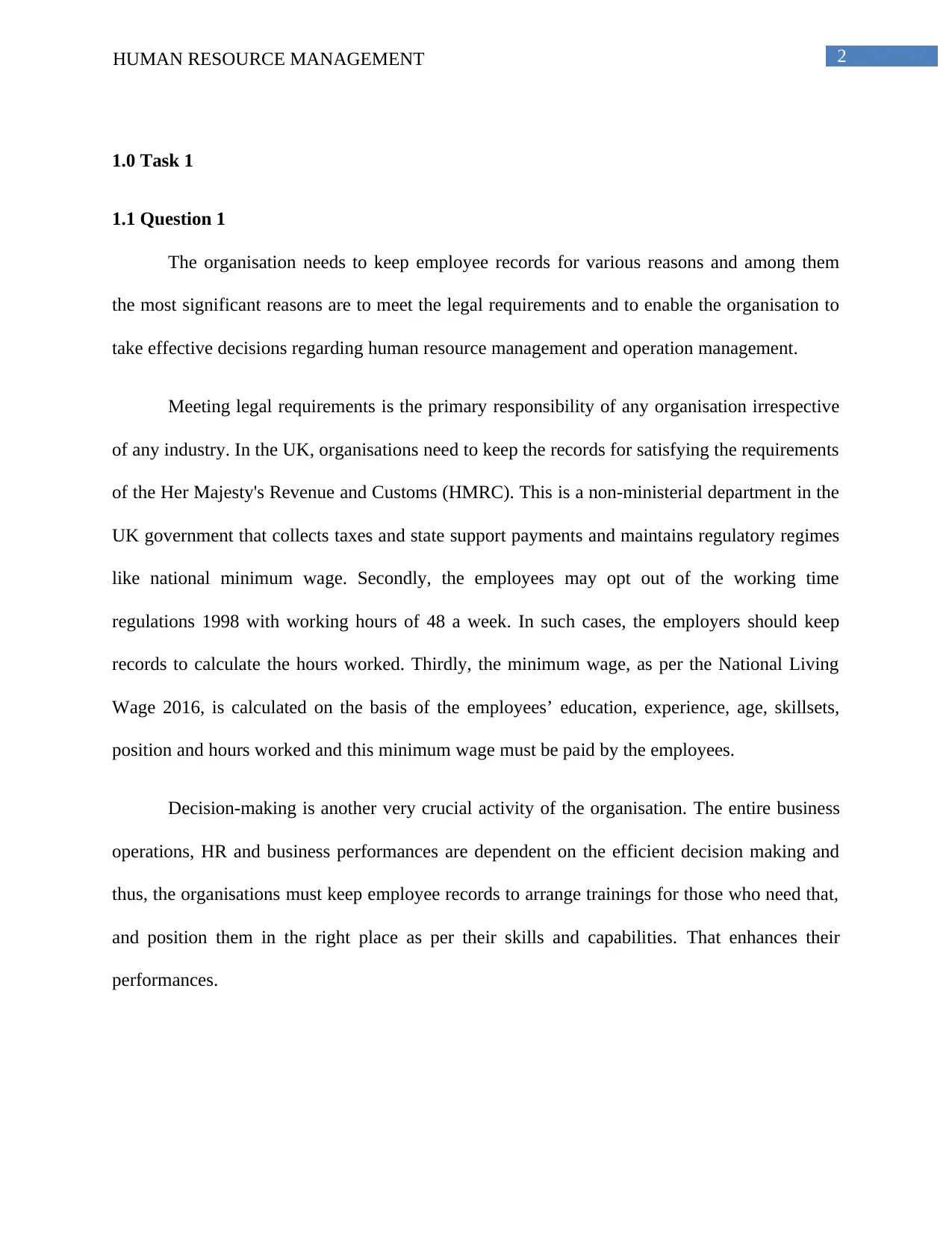
2HUMAN RESOURCE MANAGEMENT
1.0 Task 1
1.1 Question 1
The organisation needs to keep employee records for various reasons and among them
the most significant reasons are to meet the legal requirements and to enable the organisation to
take effective decisions regarding human resource management and operation management.
Meeting legal requirements is the primary responsibility of any organisation irrespective
of any industry. In the UK, organisations need to keep the records for satisfying the requirements
of the Her Majesty's Revenue and Customs (HMRC). This is a non-ministerial department in the
UK government that collects taxes and state support payments and maintains regulatory regimes
like national minimum wage. Secondly, the employees may opt out of the working time
regulations 1998 with working hours of 48 a week. In such cases, the employers should keep
records to calculate the hours worked. Thirdly, the minimum wage, as per the National Living
Wage 2016, is calculated on the basis of the employees’ education, experience, age, skillsets,
position and hours worked and this minimum wage must be paid by the employees.
Decision-making is another very crucial activity of the organisation. The entire business
operations, HR and business performances are dependent on the efficient decision making and
thus, the organisations must keep employee records to arrange trainings for those who need that,
and position them in the right place as per their skills and capabilities. That enhances their
performances.
1.0 Task 1
1.1 Question 1
The organisation needs to keep employee records for various reasons and among them
the most significant reasons are to meet the legal requirements and to enable the organisation to
take effective decisions regarding human resource management and operation management.
Meeting legal requirements is the primary responsibility of any organisation irrespective
of any industry. In the UK, organisations need to keep the records for satisfying the requirements
of the Her Majesty's Revenue and Customs (HMRC). This is a non-ministerial department in the
UK government that collects taxes and state support payments and maintains regulatory regimes
like national minimum wage. Secondly, the employees may opt out of the working time
regulations 1998 with working hours of 48 a week. In such cases, the employers should keep
records to calculate the hours worked. Thirdly, the minimum wage, as per the National Living
Wage 2016, is calculated on the basis of the employees’ education, experience, age, skillsets,
position and hours worked and this minimum wage must be paid by the employees.
Decision-making is another very crucial activity of the organisation. The entire business
operations, HR and business performances are dependent on the efficient decision making and
thus, the organisations must keep employee records to arrange trainings for those who need that,
and position them in the right place as per their skills and capabilities. That enhances their
performances.
⊘ This is a preview!⊘
Do you want full access?
Subscribe today to unlock all pages.

Trusted by 1+ million students worldwide
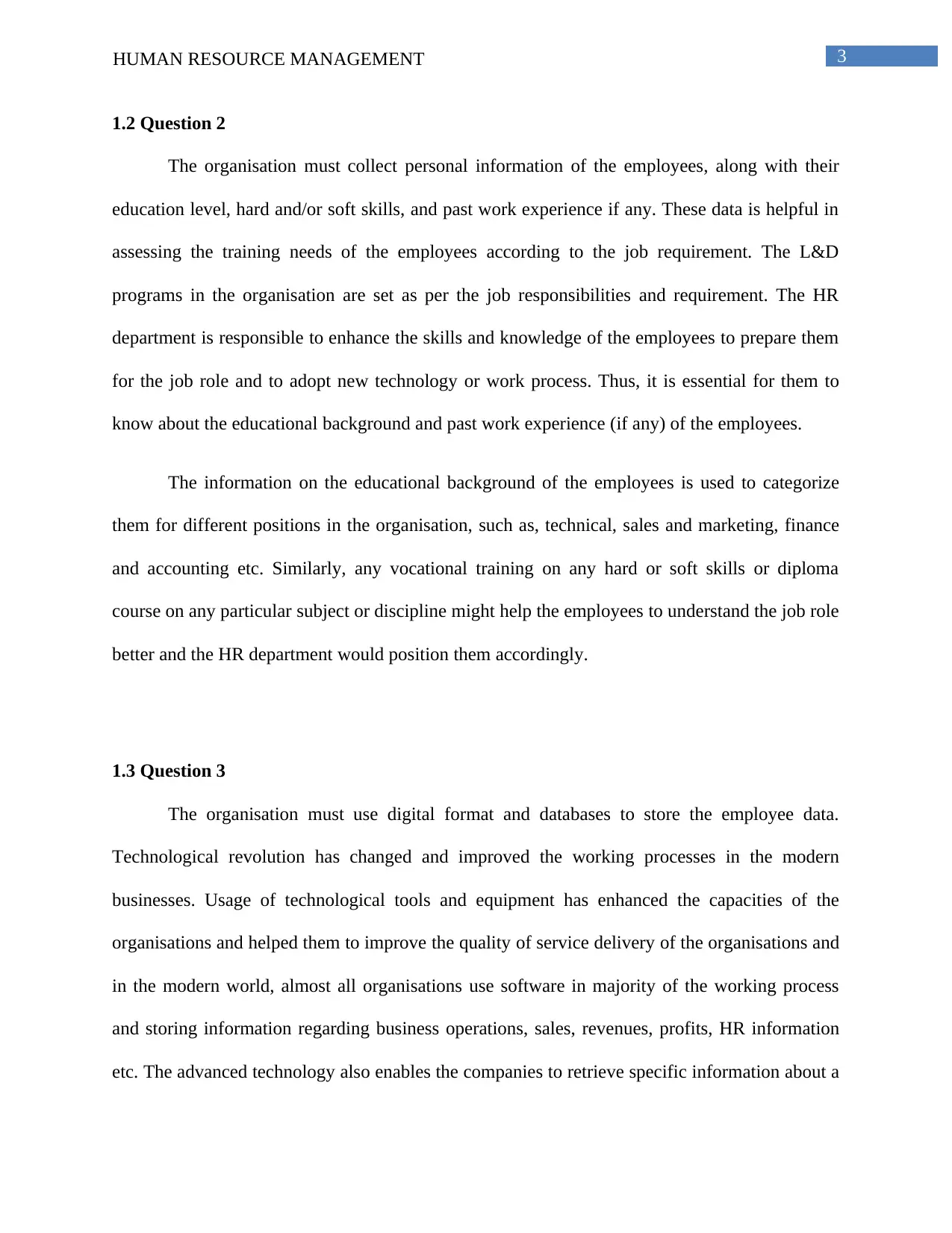
3HUMAN RESOURCE MANAGEMENT
1.2 Question 2
The organisation must collect personal information of the employees, along with their
education level, hard and/or soft skills, and past work experience if any. These data is helpful in
assessing the training needs of the employees according to the job requirement. The L&D
programs in the organisation are set as per the job responsibilities and requirement. The HR
department is responsible to enhance the skills and knowledge of the employees to prepare them
for the job role and to adopt new technology or work process. Thus, it is essential for them to
know about the educational background and past work experience (if any) of the employees.
The information on the educational background of the employees is used to categorize
them for different positions in the organisation, such as, technical, sales and marketing, finance
and accounting etc. Similarly, any vocational training on any hard or soft skills or diploma
course on any particular subject or discipline might help the employees to understand the job role
better and the HR department would position them accordingly.
1.3 Question 3
The organisation must use digital format and databases to store the employee data.
Technological revolution has changed and improved the working processes in the modern
businesses. Usage of technological tools and equipment has enhanced the capacities of the
organisations and helped them to improve the quality of service delivery of the organisations and
in the modern world, almost all organisations use software in majority of the working process
and storing information regarding business operations, sales, revenues, profits, HR information
etc. The advanced technology also enables the companies to retrieve specific information about a
1.2 Question 2
The organisation must collect personal information of the employees, along with their
education level, hard and/or soft skills, and past work experience if any. These data is helpful in
assessing the training needs of the employees according to the job requirement. The L&D
programs in the organisation are set as per the job responsibilities and requirement. The HR
department is responsible to enhance the skills and knowledge of the employees to prepare them
for the job role and to adopt new technology or work process. Thus, it is essential for them to
know about the educational background and past work experience (if any) of the employees.
The information on the educational background of the employees is used to categorize
them for different positions in the organisation, such as, technical, sales and marketing, finance
and accounting etc. Similarly, any vocational training on any hard or soft skills or diploma
course on any particular subject or discipline might help the employees to understand the job role
better and the HR department would position them accordingly.
1.3 Question 3
The organisation must use digital format and databases to store the employee data.
Technological revolution has changed and improved the working processes in the modern
businesses. Usage of technological tools and equipment has enhanced the capacities of the
organisations and helped them to improve the quality of service delivery of the organisations and
in the modern world, almost all organisations use software in majority of the working process
and storing information regarding business operations, sales, revenues, profits, HR information
etc. The advanced technology also enables the companies to retrieve specific information about a
Paraphrase This Document
Need a fresh take? Get an instant paraphrase of this document with our AI Paraphraser
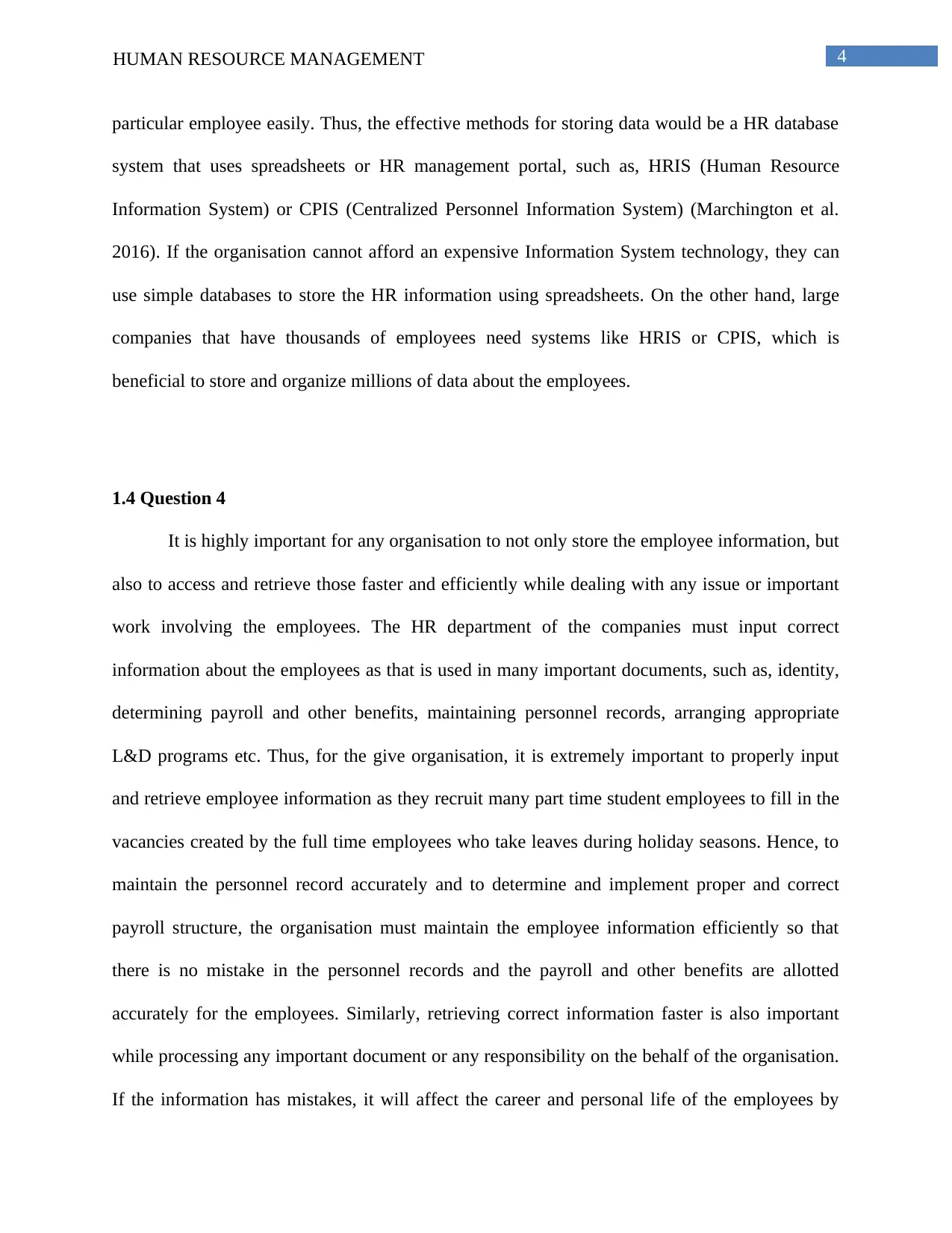
4HUMAN RESOURCE MANAGEMENT
particular employee easily. Thus, the effective methods for storing data would be a HR database
system that uses spreadsheets or HR management portal, such as, HRIS (Human Resource
Information System) or CPIS (Centralized Personnel Information System) (Marchington et al.
2016). If the organisation cannot afford an expensive Information System technology, they can
use simple databases to store the HR information using spreadsheets. On the other hand, large
companies that have thousands of employees need systems like HRIS or CPIS, which is
beneficial to store and organize millions of data about the employees.
1.4 Question 4
It is highly important for any organisation to not only store the employee information, but
also to access and retrieve those faster and efficiently while dealing with any issue or important
work involving the employees. The HR department of the companies must input correct
information about the employees as that is used in many important documents, such as, identity,
determining payroll and other benefits, maintaining personnel records, arranging appropriate
L&D programs etc. Thus, for the give organisation, it is extremely important to properly input
and retrieve employee information as they recruit many part time student employees to fill in the
vacancies created by the full time employees who take leaves during holiday seasons. Hence, to
maintain the personnel record accurately and to determine and implement proper and correct
payroll structure, the organisation must maintain the employee information efficiently so that
there is no mistake in the personnel records and the payroll and other benefits are allotted
accurately for the employees. Similarly, retrieving correct information faster is also important
while processing any important document or any responsibility on the behalf of the organisation.
If the information has mistakes, it will affect the career and personal life of the employees by
particular employee easily. Thus, the effective methods for storing data would be a HR database
system that uses spreadsheets or HR management portal, such as, HRIS (Human Resource
Information System) or CPIS (Centralized Personnel Information System) (Marchington et al.
2016). If the organisation cannot afford an expensive Information System technology, they can
use simple databases to store the HR information using spreadsheets. On the other hand, large
companies that have thousands of employees need systems like HRIS or CPIS, which is
beneficial to store and organize millions of data about the employees.
1.4 Question 4
It is highly important for any organisation to not only store the employee information, but
also to access and retrieve those faster and efficiently while dealing with any issue or important
work involving the employees. The HR department of the companies must input correct
information about the employees as that is used in many important documents, such as, identity,
determining payroll and other benefits, maintaining personnel records, arranging appropriate
L&D programs etc. Thus, for the give organisation, it is extremely important to properly input
and retrieve employee information as they recruit many part time student employees to fill in the
vacancies created by the full time employees who take leaves during holiday seasons. Hence, to
maintain the personnel record accurately and to determine and implement proper and correct
payroll structure, the organisation must maintain the employee information efficiently so that
there is no mistake in the personnel records and the payroll and other benefits are allotted
accurately for the employees. Similarly, retrieving correct information faster is also important
while processing any important document or any responsibility on the behalf of the organisation.
If the information has mistakes, it will affect the career and personal life of the employees by
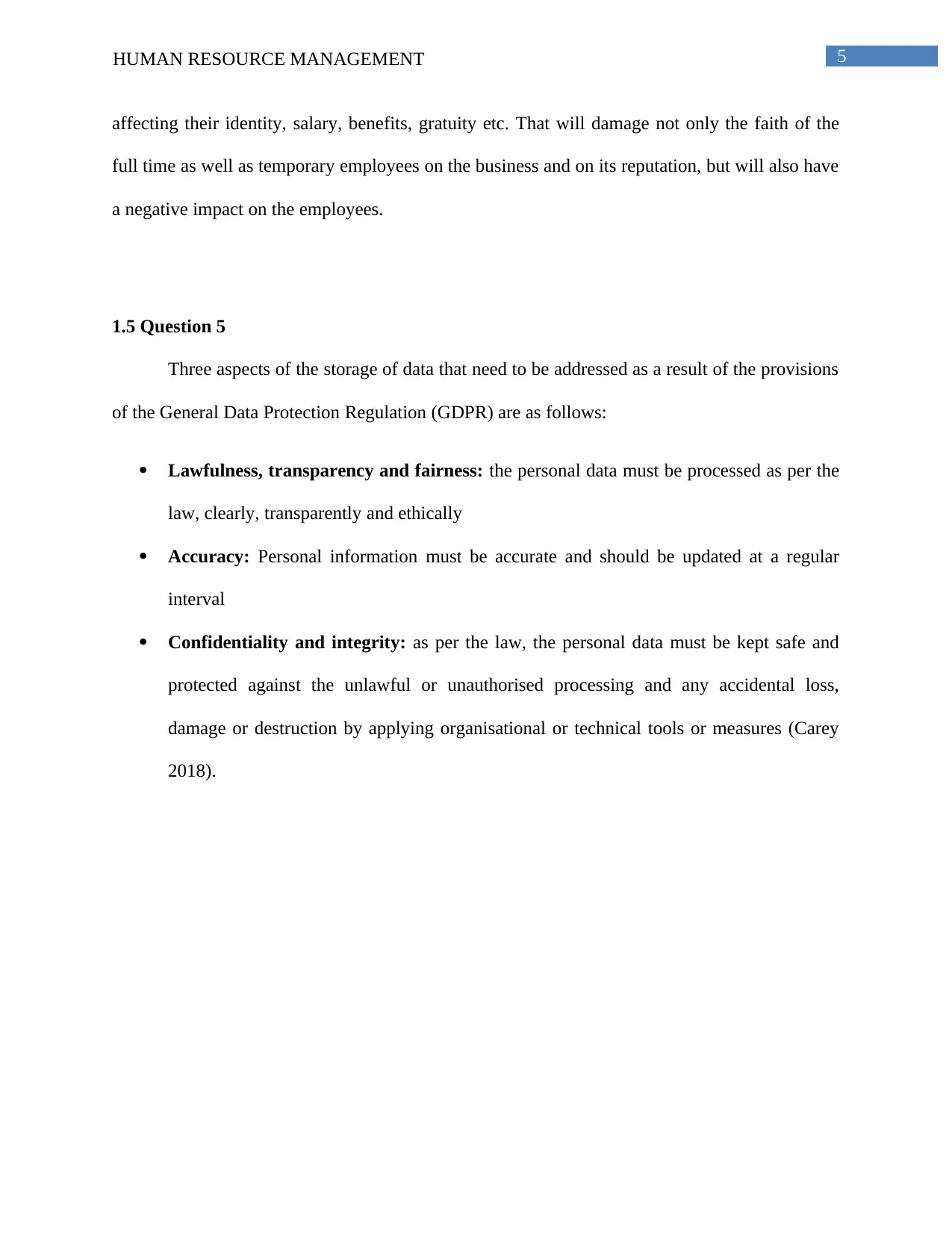
5HUMAN RESOURCE MANAGEMENT
affecting their identity, salary, benefits, gratuity etc. That will damage not only the faith of the
full time as well as temporary employees on the business and on its reputation, but will also have
a negative impact on the employees.
1.5 Question 5
Three aspects of the storage of data that need to be addressed as a result of the provisions
of the General Data Protection Regulation (GDPR) are as follows:
Lawfulness, transparency and fairness: the personal data must be processed as per the
law, clearly, transparently and ethically
Accuracy: Personal information must be accurate and should be updated at a regular
interval
Confidentiality and integrity: as per the law, the personal data must be kept safe and
protected against the unlawful or unauthorised processing and any accidental loss,
damage or destruction by applying organisational or technical tools or measures (Carey
2018).
affecting their identity, salary, benefits, gratuity etc. That will damage not only the faith of the
full time as well as temporary employees on the business and on its reputation, but will also have
a negative impact on the employees.
1.5 Question 5
Three aspects of the storage of data that need to be addressed as a result of the provisions
of the General Data Protection Regulation (GDPR) are as follows:
Lawfulness, transparency and fairness: the personal data must be processed as per the
law, clearly, transparently and ethically
Accuracy: Personal information must be accurate and should be updated at a regular
interval
Confidentiality and integrity: as per the law, the personal data must be kept safe and
protected against the unlawful or unauthorised processing and any accidental loss,
damage or destruction by applying organisational or technical tools or measures (Carey
2018).
⊘ This is a preview!⊘
Do you want full access?
Subscribe today to unlock all pages.

Trusted by 1+ million students worldwide
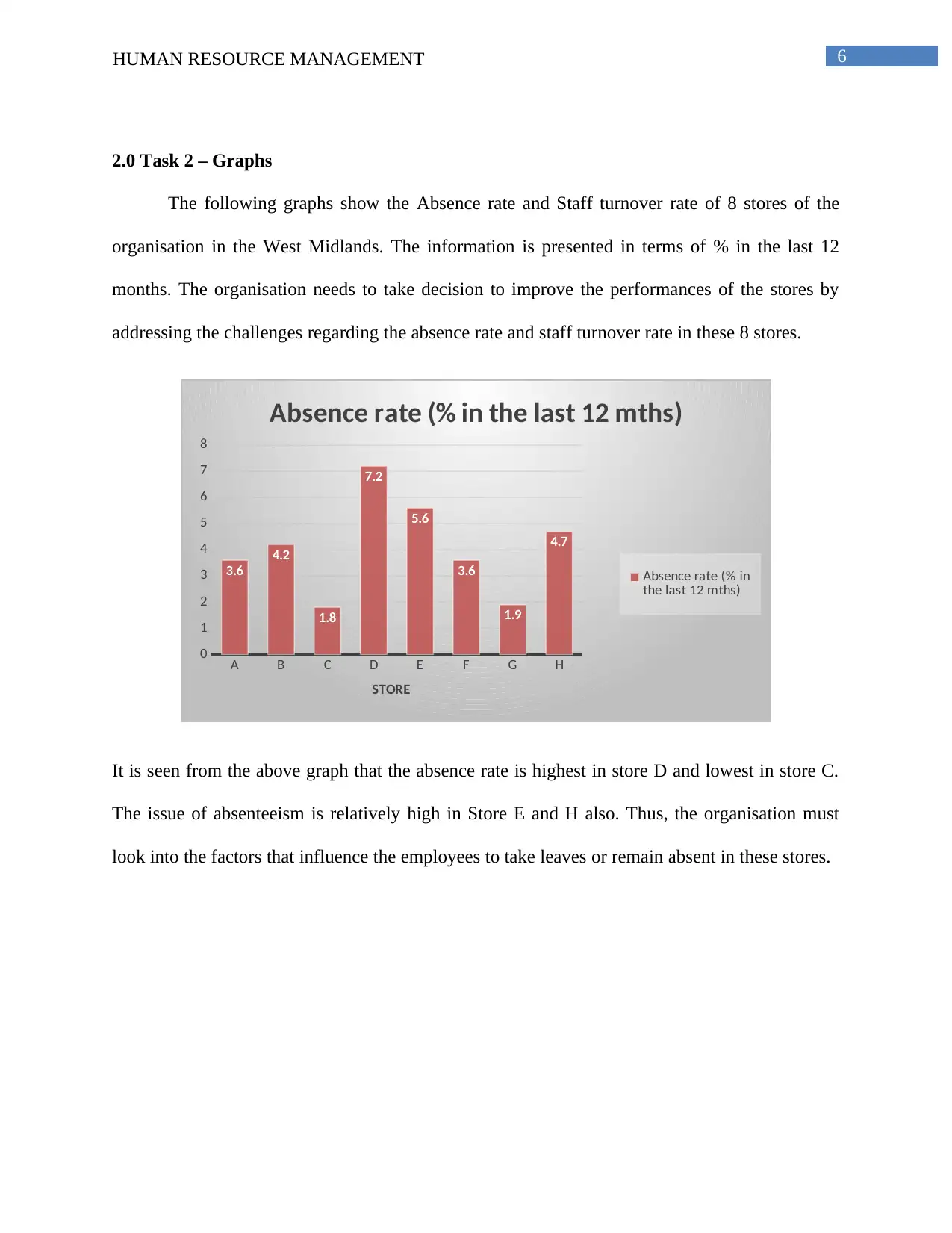
6HUMAN RESOURCE MANAGEMENT
2.0 Task 2 – Graphs
The following graphs show the Absence rate and Staff turnover rate of 8 stores of the
organisation in the West Midlands. The information is presented in terms of % in the last 12
months. The organisation needs to take decision to improve the performances of the stores by
addressing the challenges regarding the absence rate and staff turnover rate in these 8 stores.
A B C D E F G H
0
1
2
3
4
5
6
7
8
3.6
4.2
1.8
7.2
5.6
3.6
1.9
4.7
Absence rate (% in the last 12 mths)
Absence rate (% in
the last 12 mths)
STORE
It is seen from the above graph that the absence rate is highest in store D and lowest in store C.
The issue of absenteeism is relatively high in Store E and H also. Thus, the organisation must
look into the factors that influence the employees to take leaves or remain absent in these stores.
2.0 Task 2 – Graphs
The following graphs show the Absence rate and Staff turnover rate of 8 stores of the
organisation in the West Midlands. The information is presented in terms of % in the last 12
months. The organisation needs to take decision to improve the performances of the stores by
addressing the challenges regarding the absence rate and staff turnover rate in these 8 stores.
A B C D E F G H
0
1
2
3
4
5
6
7
8
3.6
4.2
1.8
7.2
5.6
3.6
1.9
4.7
Absence rate (% in the last 12 mths)
Absence rate (% in
the last 12 mths)
STORE
It is seen from the above graph that the absence rate is highest in store D and lowest in store C.
The issue of absenteeism is relatively high in Store E and H also. Thus, the organisation must
look into the factors that influence the employees to take leaves or remain absent in these stores.
Paraphrase This Document
Need a fresh take? Get an instant paraphrase of this document with our AI Paraphraser
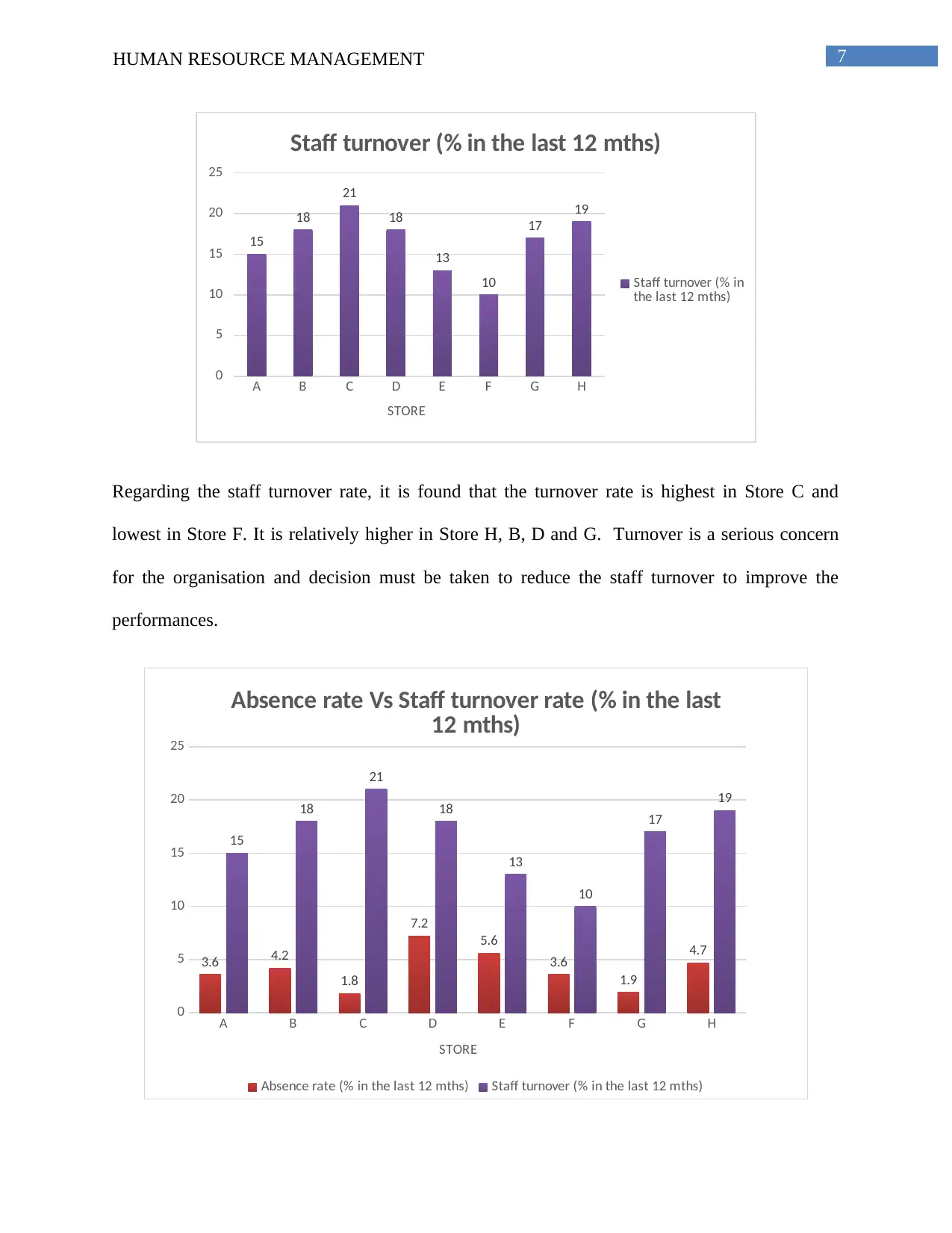
7HUMAN RESOURCE MANAGEMENT
A B C D E F G H
0
5
10
15
20
25
15
18
21
18
13
10
17
19
Staff turnover (% in the last 12 mths)
Staff turnover (% in
the last 12 mths)
STORE
Regarding the staff turnover rate, it is found that the turnover rate is highest in Store C and
lowest in Store F. It is relatively higher in Store H, B, D and G. Turnover is a serious concern
for the organisation and decision must be taken to reduce the staff turnover to improve the
performances.
A B C D E F G H
0
5
10
15
20
25
3.6 4.2
1.8
7.2
5.6
3.6
1.9
4.7
15
18
21
18
13
10
17
19
Absence rate Vs Staff turnover rate (% in the last
12 mths)
Absence rate (% in the last 12 mths) Staff turnover (% in the last 12 mths)
STORE
A B C D E F G H
0
5
10
15
20
25
15
18
21
18
13
10
17
19
Staff turnover (% in the last 12 mths)
Staff turnover (% in
the last 12 mths)
STORE
Regarding the staff turnover rate, it is found that the turnover rate is highest in Store C and
lowest in Store F. It is relatively higher in Store H, B, D and G. Turnover is a serious concern
for the organisation and decision must be taken to reduce the staff turnover to improve the
performances.
A B C D E F G H
0
5
10
15
20
25
3.6 4.2
1.8
7.2
5.6
3.6
1.9
4.7
15
18
21
18
13
10
17
19
Absence rate Vs Staff turnover rate (% in the last
12 mths)
Absence rate (% in the last 12 mths) Staff turnover (% in the last 12 mths)
STORE
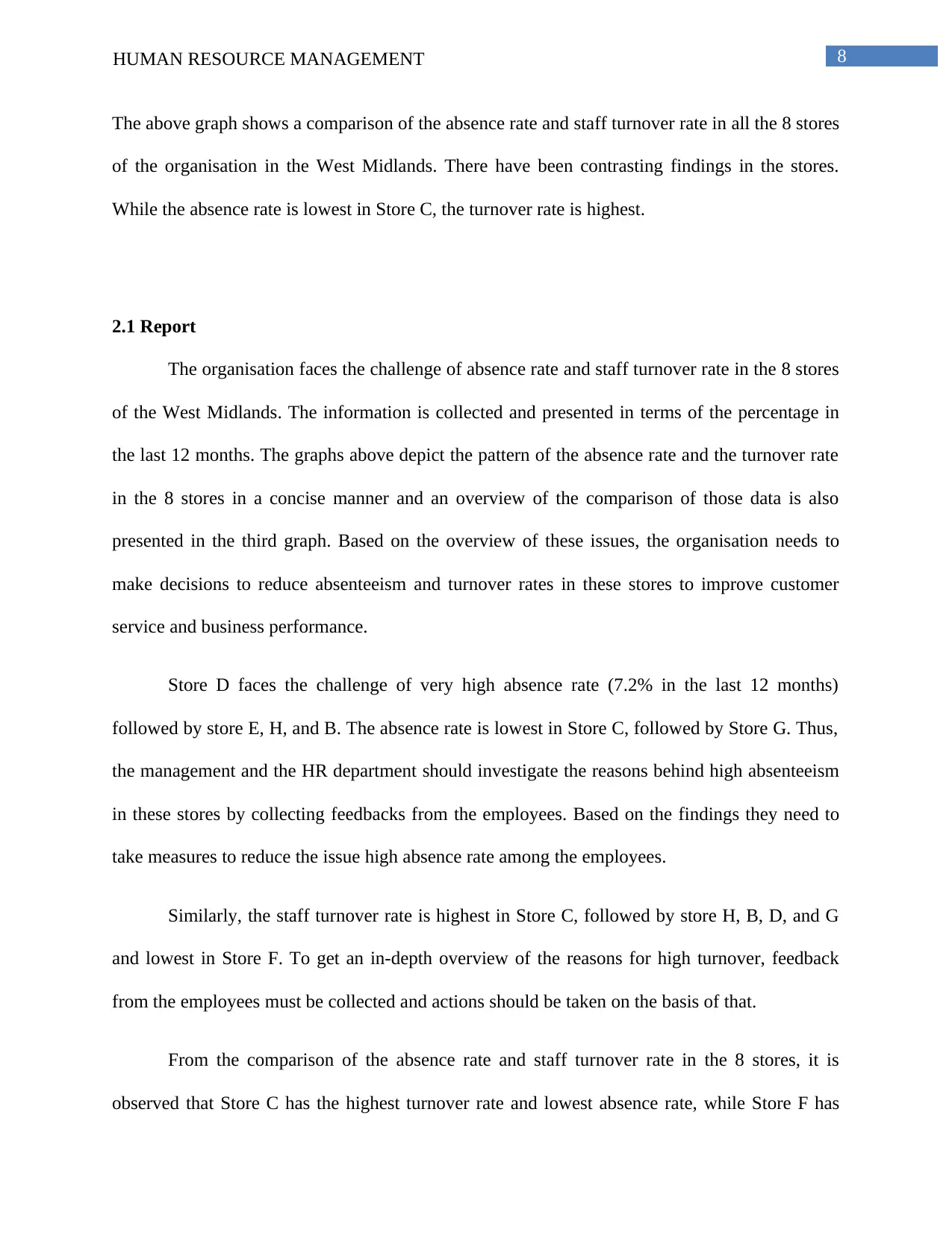
8HUMAN RESOURCE MANAGEMENT
The above graph shows a comparison of the absence rate and staff turnover rate in all the 8 stores
of the organisation in the West Midlands. There have been contrasting findings in the stores.
While the absence rate is lowest in Store C, the turnover rate is highest.
2.1 Report
The organisation faces the challenge of absence rate and staff turnover rate in the 8 stores
of the West Midlands. The information is collected and presented in terms of the percentage in
the last 12 months. The graphs above depict the pattern of the absence rate and the turnover rate
in the 8 stores in a concise manner and an overview of the comparison of those data is also
presented in the third graph. Based on the overview of these issues, the organisation needs to
make decisions to reduce absenteeism and turnover rates in these stores to improve customer
service and business performance.
Store D faces the challenge of very high absence rate (7.2% in the last 12 months)
followed by store E, H, and B. The absence rate is lowest in Store C, followed by Store G. Thus,
the management and the HR department should investigate the reasons behind high absenteeism
in these stores by collecting feedbacks from the employees. Based on the findings they need to
take measures to reduce the issue high absence rate among the employees.
Similarly, the staff turnover rate is highest in Store C, followed by store H, B, D, and G
and lowest in Store F. To get an in-depth overview of the reasons for high turnover, feedback
from the employees must be collected and actions should be taken on the basis of that.
From the comparison of the absence rate and staff turnover rate in the 8 stores, it is
observed that Store C has the highest turnover rate and lowest absence rate, while Store F has
The above graph shows a comparison of the absence rate and staff turnover rate in all the 8 stores
of the organisation in the West Midlands. There have been contrasting findings in the stores.
While the absence rate is lowest in Store C, the turnover rate is highest.
2.1 Report
The organisation faces the challenge of absence rate and staff turnover rate in the 8 stores
of the West Midlands. The information is collected and presented in terms of the percentage in
the last 12 months. The graphs above depict the pattern of the absence rate and the turnover rate
in the 8 stores in a concise manner and an overview of the comparison of those data is also
presented in the third graph. Based on the overview of these issues, the organisation needs to
make decisions to reduce absenteeism and turnover rates in these stores to improve customer
service and business performance.
Store D faces the challenge of very high absence rate (7.2% in the last 12 months)
followed by store E, H, and B. The absence rate is lowest in Store C, followed by Store G. Thus,
the management and the HR department should investigate the reasons behind high absenteeism
in these stores by collecting feedbacks from the employees. Based on the findings they need to
take measures to reduce the issue high absence rate among the employees.
Similarly, the staff turnover rate is highest in Store C, followed by store H, B, D, and G
and lowest in Store F. To get an in-depth overview of the reasons for high turnover, feedback
from the employees must be collected and actions should be taken on the basis of that.
From the comparison of the absence rate and staff turnover rate in the 8 stores, it is
observed that Store C has the highest turnover rate and lowest absence rate, while Store F has
⊘ This is a preview!⊘
Do you want full access?
Subscribe today to unlock all pages.

Trusted by 1+ million students worldwide
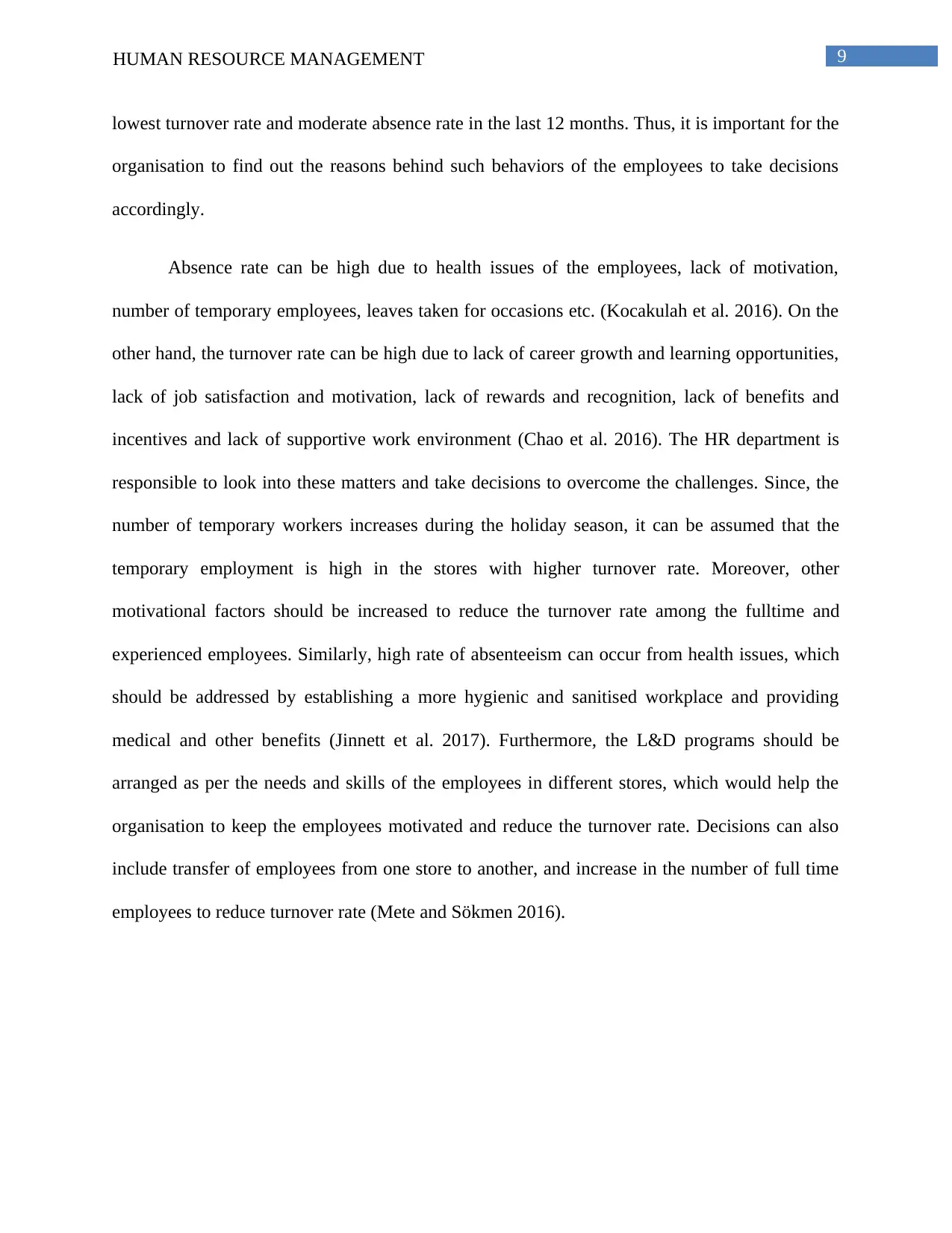
9HUMAN RESOURCE MANAGEMENT
lowest turnover rate and moderate absence rate in the last 12 months. Thus, it is important for the
organisation to find out the reasons behind such behaviors of the employees to take decisions
accordingly.
Absence rate can be high due to health issues of the employees, lack of motivation,
number of temporary employees, leaves taken for occasions etc. (Kocakulah et al. 2016). On the
other hand, the turnover rate can be high due to lack of career growth and learning opportunities,
lack of job satisfaction and motivation, lack of rewards and recognition, lack of benefits and
incentives and lack of supportive work environment (Chao et al. 2016). The HR department is
responsible to look into these matters and take decisions to overcome the challenges. Since, the
number of temporary workers increases during the holiday season, it can be assumed that the
temporary employment is high in the stores with higher turnover rate. Moreover, other
motivational factors should be increased to reduce the turnover rate among the fulltime and
experienced employees. Similarly, high rate of absenteeism can occur from health issues, which
should be addressed by establishing a more hygienic and sanitised workplace and providing
medical and other benefits (Jinnett et al. 2017). Furthermore, the L&D programs should be
arranged as per the needs and skills of the employees in different stores, which would help the
organisation to keep the employees motivated and reduce the turnover rate. Decisions can also
include transfer of employees from one store to another, and increase in the number of full time
employees to reduce turnover rate (Mete and Sökmen 2016).
lowest turnover rate and moderate absence rate in the last 12 months. Thus, it is important for the
organisation to find out the reasons behind such behaviors of the employees to take decisions
accordingly.
Absence rate can be high due to health issues of the employees, lack of motivation,
number of temporary employees, leaves taken for occasions etc. (Kocakulah et al. 2016). On the
other hand, the turnover rate can be high due to lack of career growth and learning opportunities,
lack of job satisfaction and motivation, lack of rewards and recognition, lack of benefits and
incentives and lack of supportive work environment (Chao et al. 2016). The HR department is
responsible to look into these matters and take decisions to overcome the challenges. Since, the
number of temporary workers increases during the holiday season, it can be assumed that the
temporary employment is high in the stores with higher turnover rate. Moreover, other
motivational factors should be increased to reduce the turnover rate among the fulltime and
experienced employees. Similarly, high rate of absenteeism can occur from health issues, which
should be addressed by establishing a more hygienic and sanitised workplace and providing
medical and other benefits (Jinnett et al. 2017). Furthermore, the L&D programs should be
arranged as per the needs and skills of the employees in different stores, which would help the
organisation to keep the employees motivated and reduce the turnover rate. Decisions can also
include transfer of employees from one store to another, and increase in the number of full time
employees to reduce turnover rate (Mete and Sökmen 2016).
Paraphrase This Document
Need a fresh take? Get an instant paraphrase of this document with our AI Paraphraser
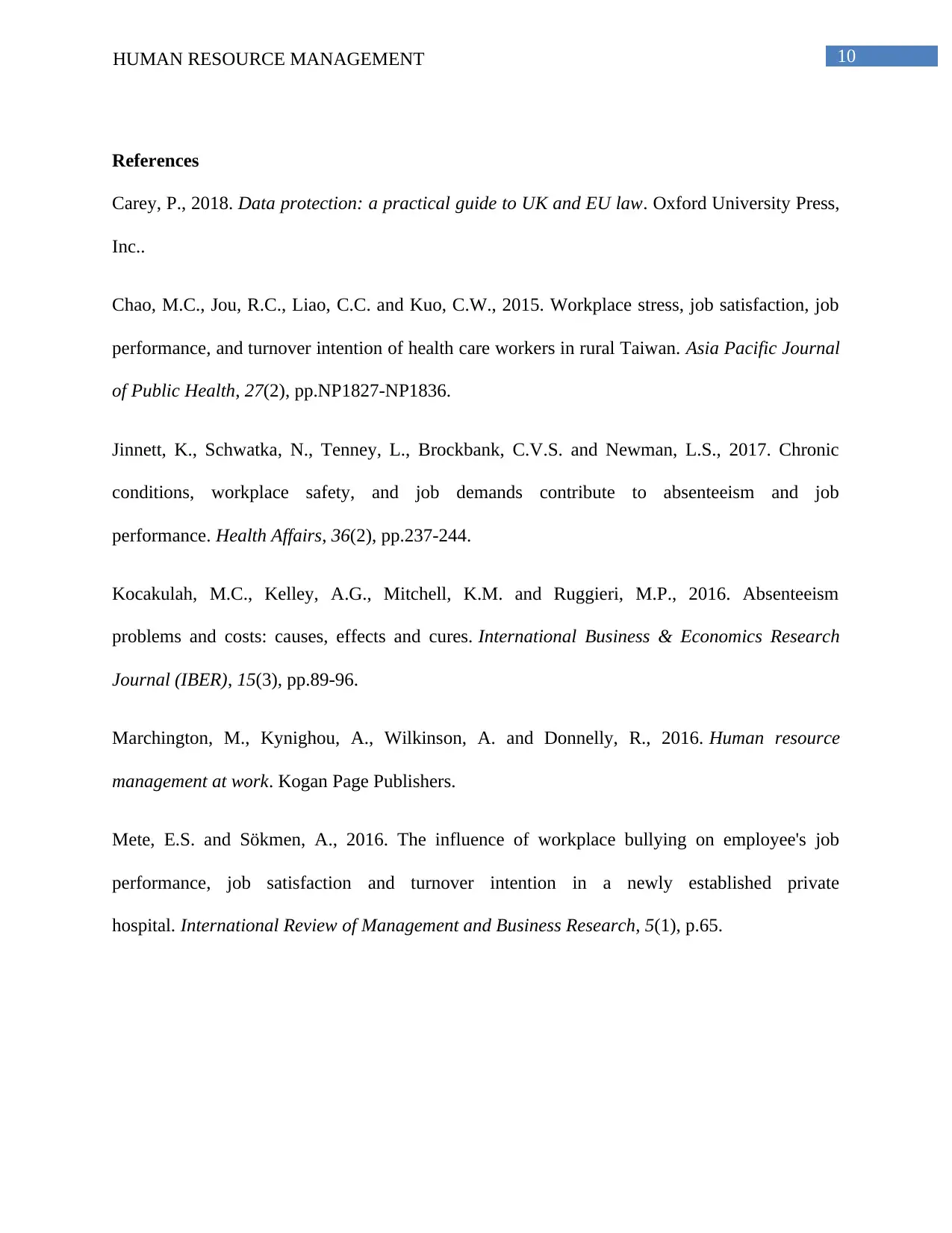
10HUMAN RESOURCE MANAGEMENT
References
Carey, P., 2018. Data protection: a practical guide to UK and EU law. Oxford University Press,
Inc..
Chao, M.C., Jou, R.C., Liao, C.C. and Kuo, C.W., 2015. Workplace stress, job satisfaction, job
performance, and turnover intention of health care workers in rural Taiwan. Asia Pacific Journal
of Public Health, 27(2), pp.NP1827-NP1836.
Jinnett, K., Schwatka, N., Tenney, L., Brockbank, C.V.S. and Newman, L.S., 2017. Chronic
conditions, workplace safety, and job demands contribute to absenteeism and job
performance. Health Affairs, 36(2), pp.237-244.
Kocakulah, M.C., Kelley, A.G., Mitchell, K.M. and Ruggieri, M.P., 2016. Absenteeism
problems and costs: causes, effects and cures. International Business & Economics Research
Journal (IBER), 15(3), pp.89-96.
Marchington, M., Kynighou, A., Wilkinson, A. and Donnelly, R., 2016. Human resource
management at work. Kogan Page Publishers.
Mete, E.S. and Sökmen, A., 2016. The influence of workplace bullying on employee's job
performance, job satisfaction and turnover intention in a newly established private
hospital. International Review of Management and Business Research, 5(1), p.65.
References
Carey, P., 2018. Data protection: a practical guide to UK and EU law. Oxford University Press,
Inc..
Chao, M.C., Jou, R.C., Liao, C.C. and Kuo, C.W., 2015. Workplace stress, job satisfaction, job
performance, and turnover intention of health care workers in rural Taiwan. Asia Pacific Journal
of Public Health, 27(2), pp.NP1827-NP1836.
Jinnett, K., Schwatka, N., Tenney, L., Brockbank, C.V.S. and Newman, L.S., 2017. Chronic
conditions, workplace safety, and job demands contribute to absenteeism and job
performance. Health Affairs, 36(2), pp.237-244.
Kocakulah, M.C., Kelley, A.G., Mitchell, K.M. and Ruggieri, M.P., 2016. Absenteeism
problems and costs: causes, effects and cures. International Business & Economics Research
Journal (IBER), 15(3), pp.89-96.
Marchington, M., Kynighou, A., Wilkinson, A. and Donnelly, R., 2016. Human resource
management at work. Kogan Page Publishers.
Mete, E.S. and Sökmen, A., 2016. The influence of workplace bullying on employee's job
performance, job satisfaction and turnover intention in a newly established private
hospital. International Review of Management and Business Research, 5(1), p.65.
1 out of 11
Related Documents
Your All-in-One AI-Powered Toolkit for Academic Success.
+13062052269
info@desklib.com
Available 24*7 on WhatsApp / Email
![[object Object]](/_next/static/media/star-bottom.7253800d.svg)
Unlock your academic potential
Copyright © 2020–2025 A2Z Services. All Rights Reserved. Developed and managed by ZUCOL.





